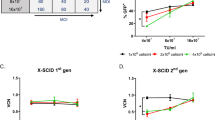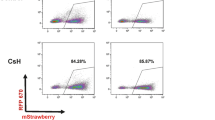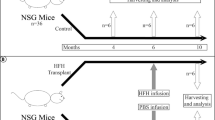Abstract
Interleukin-10 (IL-10) is an ideal candidate cytokine for suppressing the alloimmune response in transplantation. To determine whether genetic modulation of the hepatic graft with IL-10 could prolong survival following orthotopic liver transplantation, we constructed a replication-deficient adenovirus vector expressing human IL-10 (AdCMVhIL-10). Intraportal injection of this vector into a donor rat 24–48 h before grafting resulted in efficient release of IL-10 into the circulation of a recipient rat after transplantation. Moreover, levels of hIL-10 from the suprahepatic vena cava were significantly (1.48-fold) higher than those from the infrahepatic vena cava (P = 0.013), indicating local IL-10 production within the transduced hepatic graft. AdCMVhIL-10 induced a prolongation of median survival to more than 87 days, with two of five transduced grafts showing more than 100 days of ongoing survival, when compared with 11 days for grafts transduced with a control adenovirus vector carrying the E. coli β-galactosidase gene (P = 0.0021) and 11 days for untreated grafts (P = 0.0021). Pathological findings occurring in the AdCMVhIL-10-transduced hepatic grafts revealed no evidence of progressive rejection reaction resulting in graft failure. These results demonstrate that hepatic grafts modulated by IL-10 gene transfer make local and effective immunosuppression feasible in the transplantation setting.
This is a preview of subscription content, access via your institution
Access options
Subscribe to this journal
Receive 12 print issues and online access
$259.00 per year
only $21.58 per issue
Buy this article
- Purchase on Springer Link
- Instant access to full article PDF
Prices may be subject to local taxes which are calculated during checkout



Similar content being viewed by others
References
Gruber SA . The case for local immunosuppression Transplantation 1992 54: 1–11
O’Garra A . Cytokines induce the development of functionally heterogeneous T helper cell subsets Immunity 1998 8: 275–283
Schwartz RH . Models of T cell anergy: is there a common molecular mechanism? J Exp Med 1996 184: 1–8
Fiorentino DF, Bond MW, Mosmann TR . Two types of mouse helper T cells. IV. Th2 clones secrete a factor that inhibits cytokine production by Th1 clones J Exp Med 1989 170: 2081–2095
de Waal Malefyt R et al. Interleukin-10 (IL-10) inhibits cytokine synthesis by human monocytes: an autoregulatory role of IL-10 produced by monocytes J Exp Med 1991 174: 1209–1220
Yssel H et al. IL-10 is produced by subsets of human CD4+ T cell clones and peripheral blood T cells J Immunol 1992 149: 2378–2384
de Waal Malefyt R et al. Interleukin-10 (IL-10) and viral IL-10 strongly reduce antigen-specific human T cell proliferation by diminishing the antigen-presenting capacity of monocytes via downregulation of class II major histocompatibility complex expression J Exp Med 1991 174: 915–924
de Waal Malefyt R, Yssel H, de Vries JE . Direct effects of IL-10 on a subset of human CD4+ T-cells clones and T cells: specific inhibition of IL-2 production and proliferation J Immunol 1993 150: 4754–4765
Bejarano MT et al. Interleukin 10 inhibits allogeneic proliferative and cytotoxic T cell responses generated in primary mixed lymphocyte cultures Int Immunol 1992 4: 1389–1397
Groux H et al. A CD4+ T-cell subset inhibits antigen-specific T-cell responses and prevents colitis Nature 1997 389: 737–742
Buer J et al. Interleukin-10 secretion and impaired effector function of major histocompatibility complex class II-restricted T cells anergized in vivo J Exp Med 1998 187: 177–183
Ding L, Shevach EM . IL-10 inhibits mitogen-induced T cell proliferation by selectively inhibiting macrophage costimulatory function J Immunol 1992 148: 3133–3139
Fiorentino DF et al. IL-10 inhibits cytokine production of activated macrophage J Immunol 1991 147: 3815–3822
Cassatella MA et al. Interleukin 10 (IL-10) inhibits the release of proinflammatory cytokines from human polymorphonuclear leukocytes. Evidence for an autocrine role of tumor necrosis factor and IL-1 beta in mediating the production of IL-8 triggered by lipopolysaccharide J Exp Med 1993 178: 2207–2211
Wissing KM et al. A pilot trial of recombinant human interleukin-10 in kidney transplant recipients receiving OKT3 induction therapy Transplantation 1997 64: 999–1006
Chernoff AE et al. A randomized, controlled trial of IL-10 in humans. Inhibition of inflammatory cytokine production and immune responses J Immunol 1995 154: 5492–5499
Ettinghausen SE, Rosenberg SA . Immunotherapy of murine sarcomas using lymphokine activated killer cells: optimization of the schedule and route of administration of recombinant interleukin-2 Cancer Res 1986 46: 2784–2792
Blazar BR, Taylor PA, Smith S, Vallera DA . Interleukin-10 administration decreases survival in murine recipients of major histocompatibility complex disparate donor bone marrow grafts Blood 1995 85: 842–851
Shaked A et al. Adenovirus-mediated gene transfer in the transplant setting. II. Successful expression of transferred cDNA in syngeneic liver grafts Transplantation 1994 57: 1508–1511
Drazan KE et al. Adenovirus-mediated gene transfer in the transplant setting. Part III. Variables affecting gene transfer in liver grafts Transplantation 1995 59: 670–673
Roos WK et al. Isolated-organ perfusion for local gene delivery: efficient adenovirus-mediated gene transfer into the liver Gene Therapy 1997 4: 55–62
Chapelier A et al. Gene therapy in lung transplantation: feasibility of ex vivo adenovirus-mediated gene transfer to the grafts Hum Gene Ther 1996 7: 1837–1845
Qin L et al. Adenovirus-mediated gene transfer of viral interleukin-10 inhibits the immune response to both alloantigen and adenoviral antigen Hum Gene Ther 1997 8: 1365–1374
Xing Z et al. Transfer of granulocyte–macrophage colony-stimulating factor gene to rat lung induces eosinophilia, monocytosis, and fibrotic reaction J Clin Invest 1996 97: 1102–1110
Xing Z et al. Adenoviral vector-mediated interleukin-10 expression in vivo: intramuscular gene transfer inhibits cytokine responses in endotoxemia Gene Therapy 1997 4: 140–149
Boehler A et al. Adenovirus-mediated interleukin-10 gene transfer inhibits post-transplant fibrous airway obliteration in an animal model of bronchiolitis obliterans Hum Gene Ther 1998 9: 541–551
Hayashi A et al. Frequent occurrence of hepatocytic apoptosis in acute rejection of the grafted rat liver Pathol Int 1997 47: 518–524
Kamada N et al. Liver transplantation in the rat: biochemical and histological evidence of complete tolerance induction in nonrejection strains Transplantation 1983 35: 304–311
Goode HF et al. Reperfusion injury, antioxidants and hemodynamics during orthotopic liver transplantation Hepatology 1994 19: 354–359
Olthoff KM et al. Adenovirus-mediated gene transfer into cold-preserved liver allografts: survival pattern and unresponsiveness following transduction with CTLA4Ig Nature Med 1998 4: 194–200
Zwacka RA et al. Redox gene therapy for ischemia/reperfusion injury of the liver reduces AP1 and NF-κB activation Nature Med 1998 4: 194–200
Qin L et al. Retrovirus-mediated transfer of viral interleukin-10 gene prolongs murine cardiac allograft survival J Immunol 1996 156: 2316–2323
Sykes M et al. Specific prolongation of skin graft survival following retroviral transduction of bone marrow with an allogeneic major histocompatibility complex gene Transplantation 1993 55: 197–202
Moore KW et al. Homology of cytokine synthesis inhibitory factor (IL-10) to the Epstein–Barr virus gene BCRFI Science 1990 248: 1230–1234
Drazan KE et al. Transduction of hepatic allografts achieves local levels of viral IL-10 which suppress alloreactivity in vitro J Surg Res 1995 59: 219–223
Huh RD et al. Pharmacokinetics and immunomodulatory properties of intravenously administered recombinant human IL-10 in healthy volunteers Blood 1996 87: 699–705
Pescovitz MD, Sachs DH, Lunney JK, Hsu SM . Localization of class II MHC antigens on porcine renal vascular endothelium Transplantation 1984 37: 627–630
Daar AS et al. The detailed distribution of MHC class II antigens in normal human organs Transplantation 1984 38: 293–298
Herz J, Gerard RD . Adenovirus-mediated transfer of low density lipoprotein receptor gene acutely accelerates cholesterol clearance in normal mice Proc Natl Acad Sci USA 1993 90: 2812–2816
Huard J et al. The route of administration is a major determinant of the transduction efficiency of rat tissues by adenoviral recombinants Gene Therapy 1995 2: 107–115
Holler E et al. Systemic and cellular-release of IL-10 in human BMT Eur J Cancer 1995 31: 39–45
Cantwell MJ et al. Adenovirus vector infection of chronic lymphocytic leukemia B cells Blood 1996 88: 4676–4683
Graham FL, Prevec L . Manipulation of adenovirus vectors. In: Murray EJ (ed) . Gene Transfer and Expression Protocols Humana Press: Clifton, NJ 1991 109–128
Graham FL, Van Der Eb EJ . A new technique for the assay of infectivity of human adenovirus 5 DNA Virology 1973 52: 456–467
Tashiro H et al. Monitoring for rejection and engraftment following rat orthotopic liver transplantation by polymerase chain reaction Transplantation 1994 58: 745–748
Tashiro H et al. Assessment of microchimerism in rat liver transplantation by polymerase chain reaction Hepatology 1996 23: 828–834
Kamada N, Calne RY . Orthotopic liver transplantation in the rat: technique using cuff for portal vein anastomosis and biliary drainage Transplantation 1979 28: 47–50
Kamada N, Sumimoto R, Kaneda K . The value of hepatic artery reconstruction as a technique in rat liver transplantation Surgery 1992 111: 195–200
Author information
Authors and Affiliations
Rights and permissions
About this article
Cite this article
Shinozaki, K., Yahata, H., Tanji, H. et al. Allograft transduction of IL-10 prolongs survival following orthotopic liver transplantation. Gene Ther 6, 816–822 (1999). https://doi.org/10.1038/sj.gt.3300881
Received:
Accepted:
Published:
Issue Date:
DOI: https://doi.org/10.1038/sj.gt.3300881
Keywords
This article is cited by
-
Computer-aided designing of immunosuppressive peptides based on IL-10 inducing potential
Scientific Reports (2017)
-
Prolongation of heart allograft survival after long-term expression of soluble MHC class I antigens and vIL-10 in the liver by AAV-plasmid-mediated gene transfer
Langenbeck's Archives of Surgery (2008)
-
Secretion of interleukin-10 from murine colon carcinoma cells suppresses systemic antitumor immunity and impairs protective immunity induced against the tumors
Cancer Gene Therapy (2002)
-
Augmentation of local antitumor immunity in liver by interleukin-2 gene transfer via portal vein
Cancer Gene Therapy (2002)
-
Gene therapy in transplantation in the year 2000: moving towards clinical applications?
Gene Therapy (2000)



